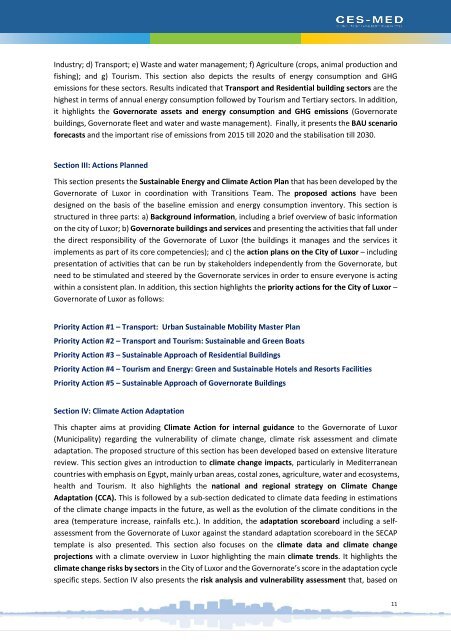130218_Luxor-Egypt SECAP Final
Create successful ePaper yourself
Turn your PDF publications into a flip-book with our unique Google optimized e-Paper software.
Industry; d) Transport; e) Waste and water management; f) Agriculture (crops, animal production and<br />
fishing); and g) Tourism. This section also depicts the results of energy consumption and GHG<br />
emissions for these sectors. Results indicated that Transport and Residential building sectors are the<br />
highest in terms of annual energy consumption followed by Tourism and Tertiary sectors. In addition,<br />
it highlights the Governorate assets and energy consumption and GHG emissions (Governorate<br />
buildings, Governorate fleet and water and waste management). <strong>Final</strong>ly, it presents the BAU scenario<br />
forecasts and the important rise of emissions from 2015 till 2020 and the stabilisation till 2030.<br />
Section III: Actions Planned<br />
This section presents the Sustainable Energy and Climate Action Plan that has been developed by the<br />
Governorate of <strong>Luxor</strong> in coordination with Transitions Team. The proposed actions have been<br />
designed on the basis of the baseline emission and energy consumption inventory. This section is<br />
structured in three parts: a) Background information, including a brief overview of basic information<br />
on the city of <strong>Luxor</strong>; b) Governorate buildings and services and presenting the activities that fall under<br />
the direct responsibility of the Governorate of <strong>Luxor</strong> (the buildings it manages and the services it<br />
implements as part of its core competencies); and c) the action plans on the City of <strong>Luxor</strong> – including<br />
presentation of activities that can be run by stakeholders independently from the Governorate, but<br />
need to be stimulated and steered by the Governorate services in order to ensure everyone is acting<br />
within a consistent plan. In addition, this section highlights the priority actions for the City of <strong>Luxor</strong> –<br />
Governorate of <strong>Luxor</strong> as follows:<br />
Priority Action #1 – Transport: Urban Sustainable Mobility Master Plan<br />
Priority Action #2 – Transport and Tourism: Sustainable and Green Boats<br />
Priority Action #3 – Sustainable Approach of Residential Buildings<br />
Priority Action #4 – Tourism and Energy: Green and Sustainable Hotels and Resorts Facilities<br />
Priority Action #5 – Sustainable Approach of Governorate Buildings<br />
Section IV: Climate Action Adaptation<br />
This chapter aims at providing Climate Action for internal guidance to the Governorate of <strong>Luxor</strong><br />
(Municipality) regarding the vulnerability of climate change, climate risk assessment and climate<br />
adaptation. The proposed structure of this section has been developed based on extensive literature<br />
review. This section gives an introduction to climate change impacts, particularly in Mediterranean<br />
countries with emphasis on <strong>Egypt</strong>, mainly urban areas, costal zones, agriculture, water and ecosystems,<br />
health and Tourism. It also highlights the national and regional strategy on Climate Change<br />
Adaptation (CCA). This is followed by a sub-section dedicated to climate data feeding in estimations<br />
of the climate change impacts in the future, as well as the evolution of the climate conditions in the<br />
area (temperature increase, rainfalls etc.). In addition, the adaptation scoreboard including a selfassessment<br />
from the Governorate of <strong>Luxor</strong> against the standard adaptation scoreboard in the <strong>SECAP</strong><br />
template is also presented. This section also focuses on the climate data and climate change<br />
projections with a climate overview in <strong>Luxor</strong> highlighting the main climate trends. It highlights the<br />
climate change risks by sectors in the City of <strong>Luxor</strong> and the Governorate’s score in the adaptation cycle<br />
specific steps. Section IV also presents the risk analysis and vulnerability assessment that, based on<br />
11

















